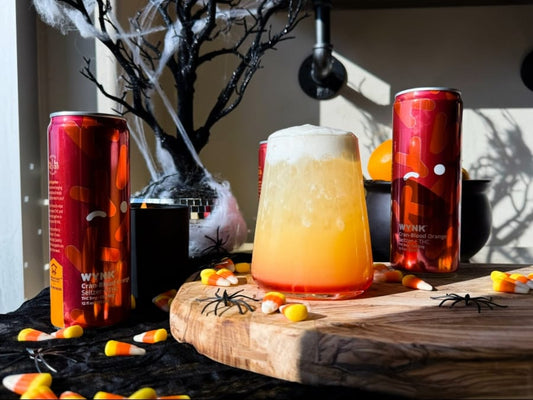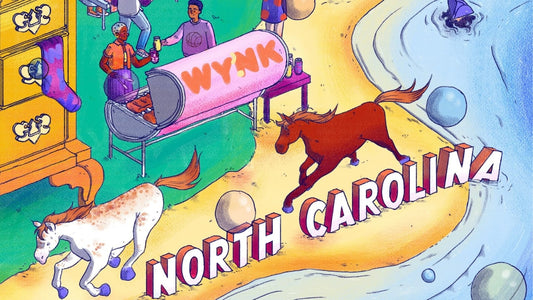Consuming cannabis is pretty easy for most: You take some and anticipate the effects in a few minutes to an hour or two. Pretty simple, right? While that's true, there's a lot more you might want to understand, because the plant's much more complex and beneficial than some may think.
It's okay if pot knowledge has flown past you. In fact, you're probably in the majority. In just a few short years, the public has been thrust into a world of legal cannabis and everything with it. For most, you may have had minimal contact with the plant for decades, if not your entire lives. Everything from plant terminology to its science is evolving as we learn about this magnificent piece of plant medicine. All the while, many folks are just trying to find out what'll get them high and if it's safe.
Before we dive further: THC gets you high, and you're safe when not involving heavy machinery. Now, back to the point…
One of the more exciting aspects of the plant you may want to learn about is its compounds, specifically the cannabinoids. Today, we'll focus on the two most commonly known compounds: THC and CBD.
Until recently, most people probably knew, at most, about cannabinoids that THC was what made them feel high. Things have certainly changed as stigmas and prohibition slowly erode.
As we learned more about cannabis and its effect on our bodies, many began to realize that THC wasn't the only factor in creating an ideal outcome. Today, much of the cannabis community—including consumers, researchers, advocates, business leaders and others—embraces the theory that these complex cannabis compounds work harmoniously to create a richer, more enjoyable experience. This theory is known as the Entourage Effect.
Each cannabis plant type, commonly known as a strain, has its unique plant profile. In most instances, the prominent compounds found include delta-9-THC, CBD, delta-8-THC and cannabinol. THC and CBD often have the largest share of a plant's profile.
In recent years, some consumers have sought after higher and higher doses of THC. At the same time, many consumers have called for lower-dose products, often requesting a less intense "high" or none at all.
To meet those demands, cultivators and companies develop numerous combinations, or ratios, of THC and CBD products. Through different ratios, consumers can have cannabis that suits their unique needs and wants. While multiple options exist and provide desired outcomes, the equal balance of 1:1 THC to CBD is what many consider The Golden Ratio—providing consumers with a positive cannabis experience without too much of a heady effect.
In this article, we'll expand on The Golden Ratio and how both cannabinoids are believed to affect our bodies in various ways.
What Are CBD And THC?
CBD and THC have their similarities and differences. The differences outweigh the similarities but each are immensely important to the results they deliver.
Both deriving from the cannabis plant, the two most prominent pot cannabinoids share a similar chemical structure containing 21 carbon, 30 hydrogen and two oxygen atoms. Those atoms are crucial in providing the various effects consumers receive.
With THC-dominant strains, scores of consumers report experiencing effects to the body and head, or consciousness. When our state of consciousness changes, it is called a psychoactive effect—you might also know this as “getting high.” THC's psychoactive effect is due to how it interacts with specific cannabinoid receptors in the brain—CB1 and CB2. These receptors exist in everyone—even if you've never used cannabis before—and are known as the endocannabinoid system.
CBD-rich strains can provide both medical and recreational consumers desired outcomes. However, you aren't likely to notice the effects the way you might with THC.
Rather than binding to CB1 and CB2 receptors, some may say that small doses of THC found in CBD technically makes it psychoactive. CBD is believed by some to regulate how cannabinoids, including THC, interact with the body, not the mind. Under US law, CBD-dominant strains must have less than .3% THC.
Regardless if you consider CBD psychoactive or not, one of the more exciting ways CBD regulates cannabinoid effects may be how it "offsets" the impact of THC. While there is still more research to be done, various studies have indicated CBD has the potential to reduce or prevent someone from experiencing unwanted effects from taking in an excessive dose of THC.
How THC And CBD Are Believed To Interact
Good news-bad news first: We lag way behind on cannabis research but research is gaining ground!
Most cannabis research has been held back for decades thanks to worldwide plant prohibition. Over the past 20 years, clinical analysis has been on the uptick as laws shift worldwide. Still, a lag remains, leaving us to play catch up on years of crucial clinical examinations.
Research can be slow, thanks to various factors. Typical hurdles include a slow grant approval process. The quality of federally-approved cannabis also has a terrible reputation. Until a recent Drug Enforcement Agency (DEA) ruling, pot used for studies came from a single manufacturer. Researchers regularly complained that the stuff they were given didn't match the quality of today's cannabis. As such, studies were inaccurate and less than ideal for today.
We're now on the way to better understanding THC and CBD. Still, practically every study concludes with a call for further research. THC and CBD interaction is no different.
While the clinical world calls for more studies into cannabinoid interactions, many researchers have noted that CBD shows signs of reducing THC's effects. Today, we have some medical studies and scores of anecdotes to consider. They include a 2018 analysis that considered memory and cognition protection as CBD's standout benefit.
We still have much to learn, but we're getting there. And finding helpful research has gotten better too. In 2020, researchers at Penn State put together a comprehensive list of THC and CBD drug interactions known today to be used as a readily available resource for other studies and researchers.
Several Areas Of Promise
There's no doubt that there is a demand for more research on the subject. At the same time, what studies we do have and decades of anecdotal evidence show that the Entourage Effect may help address several conditions.
Headlined by THC and CBD, cannabis may be showing promise in the following areas:
Cannabis for Pain
Select research and scores of personal reports acknowledge that the Entourage Effect may help with various pains. All the while, the demand for pain management remains critical. In 2018, an estimated 50 million Americans suffered from chronic pain of some sort. With cannabis, millions of people are claiming to find relief with cannabis products.
Pain has been central to the medical cannabis reform movement from its earliest days in the 1960s. As HIV/AIDS and cancer ravaged the world in the 1980s, many patients used edibles to manage pain.
The sports world has taken notice too. Several organizations have changed their cannabis policies in recent years. In 2018, the BIG3 basketball league became the first to allow players to use CBD. UFC did the same in 2018 and in 2021 announced that fighters would only be punished for THC use if they were proven to use it as a performance enhancer. Meanwhile, America's "Big 4" sports—NBA, NFL, MLB, and NHL—have relaxed testing or removed cannabis compounds from their banned substances list.
Cannabis for Anxiety
While research is still far behind the market, one of the more analyzed areas is anxiety relief, a condition that affects roughly 40 million Americans each year.
What makes things worse is that anxiety is all around us, every day. Think about it: The world tends to stress us all out for one reason or another. The past few years have only made things more intense and sometimes daunting. If it isn't one stressful thing, it's another. From our daily struggles to global concerns, we are all prone to suffering from anxiety.
Many have claimed for decades that cannabis helps reduce anxiety of many types. Recent studies have supported those long-held beliefs, concluding that cannabis may help people suffering from PTSD and numerous others looking to cope with stress.
Cannabis for Sleep
Approximately 70 million Americans report difficulties with temporary sleeplessness.
Through mostly anecdotal reports, cannabis has long been regarded as a sleep aid, particularly cannabis strains that induce sedation, or a "couch-lock," effect.
Various studies have tested the anecdotal evidence, with several inconclusive results. A 2019 CBD-based study of 72 adults saw sleep scores improve for 59 patients within the first month of using CBD. Still, many saw their scores fluctuate over more extended periods. Only three subjects did not see "well-tolerated" results during the test.
In 2021, a study explored the effect of medical cannabis use on insomnia patients. Researchers noted a significant symptom reduction when using indica strains. However, it should be noted that not all indicas produce desired sedative effects and that a plant's profile could alter outcomes.
Why Use The Golden Ratio?
Everyone prefers a different dose, but The Golden Ratio rings true for scores of consumers.
We agree with scores of cannabis consumers and experts that view 1:1 CBD:THC product as The Golden Ratio. While opinions can vary, it's hard to argue the power and value of a 1:1.
With an equal-dosed product, like Wynk beverages, consumers get a balanced consumption experience where THC or CBD equally contributes to the result. With THC, consumers experience full-body effects, providing physical and psychoactive relief. In some consumers, equal parts CBD have been reported as providing non-psychoactive body effects. Some reports conclude CBD may also deliver a countereffect to any negative THC experiences that may arise.
What About Other Ratios?
Cannabis is not one-size-fits-all. Each person's body reacts to cannabis differently. What works for many may not for you, and that's perfectly fine.
This case is particularly true for medical consumers. Depending on your needs and wants, you may benefit more from products containing a cannabinoid ratio like a 2:1, 5:1, 10:1, 20:1, or even more significant.
For recreational consumers, a 1:1 is ideal for the canna-curious, newcomers, or anyone seeking a balanced experience. Starting with a low dose like 2.5 mg is an excellent way to experience cannabis without worrying about overconsuming THC—making it an ideal, or dare we say golden, option for many consumers.
Give Golden Ratio Infused Beverages A Try Today
Cannabis-infused beverages are the future of cannabis consumption, and it's not just because Wynk makes one heck of a delicious option—though that helps.
Beverages grew from a relatively small choice of possibilities to a world of options. Now, you can enjoy cannabis in just about any drink. Infused drinks now represent one of the most effective, discrete, and refreshing consumption methods today. Lab-tested and accurately dosed, options are no longer the uncertain consumption experience they were before legalization. And with a 1:1 THC:CBD beverage, consumers can enjoy a balanced cannabinoid experience that other ratios don't offer.
While it's always true that everyone's experience is unique, most can't go wrong with equal parts THC and CBD in their consumption experience. Newcomers and veterans alike seem to benefit from the Entourage Effect and The Golden Ratio. Find out for yourself with a 2.5mg can of Wynk seltzer today.
Andrew Ward is a Brooklyn, NY based freelance journalist and copywriter. Some of Andrew's notable publications and clients include High Times, Benzinga, Business Insider, Rolling Stone and many more.




